Drug Delivery Roundtable: More than the Pill
Pharmaceutical Executive
Can novel drug delivery technologies offering options beyond the traditional tablet or syringe transform the therapeutic experience for patients?
One of the more exciting trends in science today is the innovation taking place in the way medicines are administered, absorbed, and tolerated in the human body. It’s no longer just about the pill or syringe-new testing and delivery platforms, from the 3D

printing of molecules to ingestible miniaturized “nanobots” targeting pathogens directly through the bloodstream-promise more precise therapeutic outcomes as well as the standard benefits from increased utilization and higher rates of adherence.
To assess prospects for this neglected branch of the medicines discovery tree, Pharm Exec recently convened a Roundtable with top executives from four start-up companies committed to scoring big in this emerging field. The consensus? There is both promise to patients and profits to producers in stretching what is feasible in the process of drug delivery.
PE: Innovation in the way that medicines are administered and absorbed in humans is emerging as an important driver of industry R&D. Can you explain your company’s contribution to these new technologies focused on platform process improvements to drug delivery?
Robert Clarke, CEO, Pulmatrix Inc.: Pulmatrix is a pulmonary drug delivery company with a novel inhalable dry powder technology, iSPERSE, invented in-house. Our platform allows us to deliver most classes of drugs, from small molecules to biologics, to patients in a manner that is both tolerable and efficacious. Compliance is also very important because our delivery platform ensures that patients will get the prescribed dosage, even on their worst day. Our lead investigatory program is an inhaled anti-fungal drug for cystic fibrosis, which will represent a therapeutic advance against the current oral anti-fungal regimen, administered at a high dose, and with lower tolerability due to side-effects. We are also testing the technology for inhalation treatment of idiopathic pulmonary fibrosis, a relatively rare
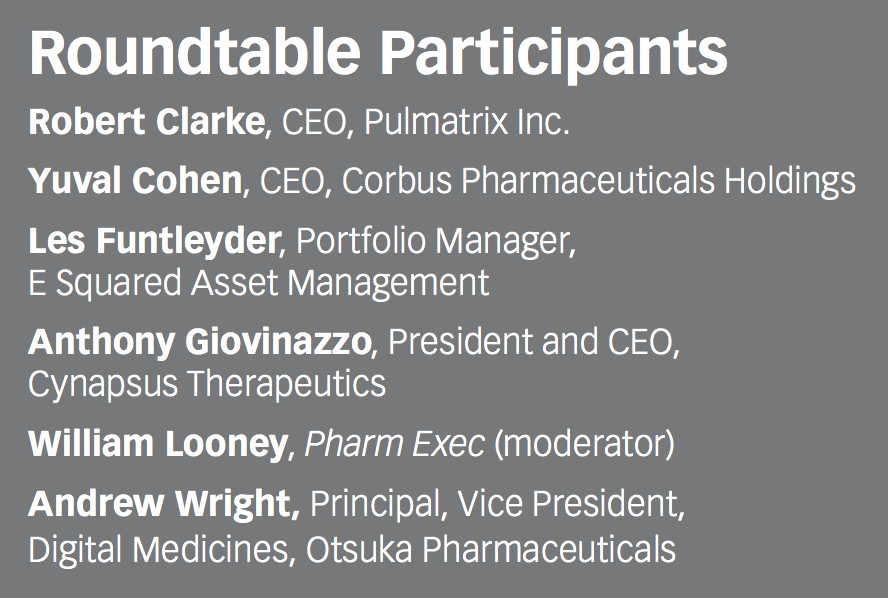
condition with few options for patients.
PE: How does administering the drug directly to the lung work better than a pill or injection?
Clarke: Fungal infection occurs in the airways; reliance on a pill or syringe is a secondary pathway to the pathogen. Airborne fungal spores harbor the infection and deposit in the airways after inhalation. The nice thing about our inhalable technology is that you can match the drug to the size of the fungal spore and attack the condition directly at source. This potentially enhances its efficacy as a treatment, with a higher prospect of achieving the intended therapeutic outcome due to the higher lung tissue levels.
Yuval Cohen, CEO, Corbus Pharmaceuticals: Corbus is a new company-we were founded in the spring of 2014. Our mission is directed toward orphan diseases originating from deficiencies in the human immune system. These deficiencies can result in an inflammatory response that can damage human tissues, with severe morbidity and high mortality. The approach we are taking is different than current clinical research efforts that focus on blocking or suppressing inflammation.
Instead, we are studying how to “reprogram” the immune response by activating an endogenous process known as “resolution of inflammation.” This is the process by which an activated immune system returns to homeostasis. This occurs routinely in healthy individuals via a cascade of signaling molecules, triggered by endocannabinoids. The point here is our therapeutic aim is not to suppress the immune response itself but to nudge it back to normal before it can cause more damage through inflammation.
We are testing our lead drug candidate, resunab, for treatment of cystic fibrosis (CF). Resunab has received fast-track status and orphan-drug designation from the FDA. It has demonstrated efficacy in preclinical models for inflammation and fibrosis and is now undergoing a Phase II study for treatment of CF with $5 million in financial support from the CF Foundation. We expect to share the results of this study by the end of 2016. We are also studying the efficacy of this compound in two additional autoimmune conditions-systemic sclerosis and dermatomyositis.
Andrew Wright, Vice President, Digital Medicine, Otsuka America Pharmaceutical Inc.: In 2012, Otsuka signed an agreement with California-based Proteus Digital Health Inc. to develop a digital medicine drug/device combination tablet that measures medication-taking patterns. With the patient’s consent, our drug/device is able to share personalized health information with their authorized healthcare professionals and caregivers. A key component is an ingestible sensor which communicates with a wearable sensor that measures medication ingestion and certain physiological responses. The accompanying software is installed and used across various mobile devices and personal computers as a secure, web-based application. This information provides objective data to physicians and may contribute to better healthcare delivery for patients.
If approved by the FDA, the drug/device combination will measure adherence to Otsuka’s Abilify (aripiprazole), which is indicated for treatment of schizophrenia, manic/mixed episodes of bipolar disorder and as an adjunctive treatment of major depressive disorder. Many people with these diagnoses face challenges in taking their medication as prescribed, which can lead to disease relapse and recurrence. But this device and related technology may encourage patient engagement by allowing individuals to gain insights about their medication ingestion and biophysical activity, helping them become informed consumers of care rather than a passive beneficiary. Our filing with the FDA for the drug/device is examining human factor studies to examine patients’ ability to use the technology.
Anthony Giovinazzo, President and CEO, Cynapsus Therapeutics: We are a specialty CNS pharmaceutical company based in Toronto, Canada. Our current objective is to commercialize a fast-acting and easy-to-use sublingual thin-film for the management of debilitating OFF episodes associated with Parkinson’s disease. OFF episodes, where symptoms of Parkinson’s disease reemerge after regular use of conventional drug therapy, are very frequent and add to uncertainty and quality-of-life issues for patients.
Our lead drug candidate, APL-130277, is a reformulation of an already registered product, apomorphine, a dopamine agonist (not a narcotic). We are developing it to give Parkinson’s patients with OFF episodes an easy-to-use, on-demand product that can be applied quickly to address this condition immediately, as it occurs. We think apomorphine, delivered with our film strip taken orally, is far more convenient than the current standard of treatment, an injectable drug that is often not available when needed, can be painful to administer, and can result in adverse injection site reactions.
Prospects for our therapy rests on a strong foundation, with an experienced management team, extensive IP and trade secret protection, an abbreviated Section 505 [B] [2] regulatory pathway, and solid financing, with a fresh injection of funds received in 2015 at the time of our Nasdaq IPO.
PE: I’d like to ask Les Funtleyder, Pharm Exec’s Editorial Advisory Board member and in-house investment analyst, to comment on the trend toward process technology innovation as exemplified by the portfolios of these three companies.
Les Funtleyder, E Squared Asset Management: These are companies with early stage products or pipelines with a small cap investment tag. They conform to our desire to look for novel products developed by transformational companies. The risk investors take is so high that we seek a reward that exceeds what we could obtain by investing in a big company like Pfizer. The difference is stark: whereas we might expect a 7% return on our investment in Pfizer, that return might have to reach the 700% range or above in the case of a privately-held start up.
However, it is a great time to be an investor. The science behind these products is very interesting, driven by progress in our understanding of molecular biology and genomics.
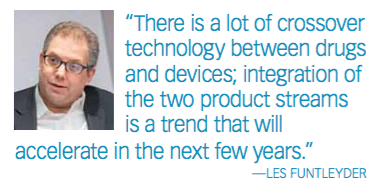
There is a lot of crossover technology between drugs and devices; integration of the two product streams is a trend that will accelerate in the next few years.
The down side from the abundance of new science is the difficulty of assessing all the opportunities. It also raises the prospect of a misallocation of capital, as evidenced by the fantastically high valuations of some start-up biotech companies and healthcare in general. The higher the valuation of an asset, the more capital you require to play in that space. The risk of financial exposure grows in tandem, which is one reason we are starting to see a pullback in available capital along with some caution about investing in the sector.
Companies here today are also aware of the risks involved in securing market access for their novel technologies. Regardless of their clinical merits, if the companies don’t nail down a commitment to payer reimbursement, they risk being left behind. It’s almost like presenting a legal case, and the prep work must begin very early in the product cycle. This can be a diversion-a costly one for a smaller start-up operation.
PE: Have you assessed the merits of digital health as a high potential market segment?
Funtleyder: We have taken a stake in two digital health enterprises. You can say we are voting with our checkbook-an indication we think the trend toward digital is real. One is Otsuka’s health engine, which allows patients to comparison shop for different types of provider services. The other is TextPro Analytics, which works with accountable care organizations (ACOs) to manage their spending and cost exposures. The challenge is that much of the activity around digital health is aspirational. A lot of money has been put forward, with relatively little return. We have not yet seen digital health becoming essential to those real-life interactions in medicine.
PE: In a larger context, have information and related analytics shaped decisions on your product offering and value proposition to regulators, payers, and patients?
Cohen: Not a great deal. One example I can cite from our experience is the work of the Cystic Fibrosis Foundation in developing a patient registry, which now includes data from 95% of CF patients in the US. The registry covers, among other things, the type of gene mutation associated with the patient’s condition as well as patient participation in clinical trials. No other patient advocacy group in the rare disease space comes close to this level of detail. The registry is useful to our research and clinical trial work. Vertex Pharmaceuticals used the registry to get 1,000 CF patients enrolled in its Phase III Combi study in only three months. The speed in which the trial was enrolled would not have been possible without access to the registry.
Wright: Our data shows that spending on digital health is growing very fast, with investments focused on six categories: wearables and biosensing; big data analytics; consumer health engagement; telemedicine; electronic health records; and eClinical applications. US Federal Reserve Bank policies are making it easier to push investments
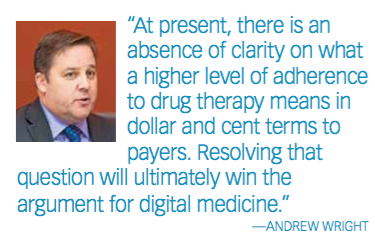
into this segment through mechanisms like Series A bonds. But it is still taking time to realize the necessary convergence between high tech and biotech so that investors see the potential from these two streams of product innovation.
Ultimately, what the value of digital medicine will be depends on how it helps manufacturers evidence outcomes that are meaningful to payers. At present, there is an absence of clarity on what a higher level of adherence to drug therapy means in dollar and cent terms to payers. Resolving that question will ultimately win the argument for digital medicine.
Cohen: If we can offer a sophisticated, evidence-based argument on how medicines create savings for the health system by keeping patients healthy or alleviating their symptoms, then we will have a sustainable business model in biopharma. If our industry cannot do that, then we will be in trouble.
Giovinazzo: Our objective is simple. We plan to align ourselves with the current standard of care product costs for Parkinson’s disease patients vs. setting a price that is [many] multiples beyond the pricing of the current competitor.
PE: The new drug delivery technologies you are developing often require a different approach to securing regulatory approval. How receptive is the FDA and other national approval authorities to advancing your commercialization objective? Where are the gaps that should be filled to help the approval system work better for your business?
Clarke: The essential task is to stay on top of how the FDA works, day to day. In our case, that requires staying in close touch with the FDA pulmonary branch as well as other branches with whom the pulmonary staff consults, including the rare disease and infectious disease groups. Each branch has its own areas of focus and specific approach that we’ll need to navigate. For example, views on clinical trial design issues might differ. Understanding that the therapeutic experts are ultimately the ones driving the bus will avoid potential pitfalls.
Another point to emphasize is our device has a tangible physical outcome, where you put a capsule in, close it, and then inhale, with dosing cues for the patient based on the sound created by the capsule spinning. Demonstrating how it works from a physical context allows us to take some of the safety and efficacy issues-that often create problems for a complex biologic drug-off the table.
Third, engaging productively with the FDA is accentuated when you can count on support from disease advocates-in our case, the Cystic Fibrosis Foundation. Having the Foundation in our court and relaying their feedback helps us in our work with the FDA.
Finally, one other issue is the different standards on registration between the US and the EU, which are the two critical gatekeepers if you want to market your product globally. From our work on inhalable devices, we find the European Medicines Agency (EMA) is far more accommodating regarding the rules of engagement. One of our other development programs is a copy of a bronchodilator that opens the airways for chronic obstructive pulmonary disease (COPD) patients. Under EMA rules, we can seek approval based on pharmacokinetic bioequivalence. That option is not yet permitted by the FDA, which complicates the global market potential for our innovations. Understanding such differences in expectations and the rules between geographies is vital to our development programs.
Cohen: Conflicting national standards relating to approval are an efficiency constraint. In Europe, we have clinical trials on CF underway in five countries. We must obtain approvals and process our trial work in each country, which can become a major headache in terms of duplication of effort.
Wright: We are dealing with multiple divisions of the FDA in the pursuit of our mobile medical app and drug/device combination. There is a positive element here because what we do will help facilitate an agency consensus on how to handle these emerging technologies in the future. On the other hand, you need substantial resources to help move the process forward, which is lacking in many start-ups and small cap companies.
Clarke: I think we all agree that regulatory agencies must put safety first-no exceptions. If that commitment requires a longer process and more paperwork, it’s our default position not to criticize the desire to err on the side of caution.
Giovinazzo: The challenge is how to think outside the box to generate innovative solutions. First, Cynapsus is using the 505[B][2] pathway to seek FDA authorization of our product. It is fortunate that the active ingredient we are using is an already approved product, which gives us the opportunity to rely on previously conducted studies required for the original new drug application (NDA) approval. This provides a faster, less expensive route to approval compared to the traditional path. More such creativity in navigating the regulatory process in diseases with significant unmet needs would improve prospects for other companies in the life sciences.
Second, regulators must be supportive and encouraging of partnerships between companies. We think the future business model will consist of new breakthrough technologies developed by smaller, nimbler companies, funded through partnering with larger firms or organizations.
PE: How important is a FDA designation of fast track, breakthrough, and orphan drug status to the ultimate commercial potential of your technology?
Cohen: It is important, especially in attracting the attention and support of potential investors and market observers. Designation also gives you a more attentive hearing from FDA reviewers. We view it as a big de-risker overall.
PE: Many of the new platform delivery devices rely on software packages and other digital technologies-enhanced information-gathering capabilities is an important aspect of their appeal to the market. Is the regulatory climate supportive of this trend?
Wright: We have not mentioned the emergence of individual privacy and cyber-security as a regulatory issue in the health information space. There are significant time and cost considerations that are now being acknowledged as a factor in assessing the business potential. Our experience at Otsuka underscores the importance of retaining security specialists and legal experts at an early stage in the design of a mobile app or device.
PE: We have spoken about the importance of engaging patients in developing new delivery platform technologies, largely through joint consultations with the major disease advocacy organizations like the CFF. What about the more unstructured interactions like those that take place with individual patients? How is the social media space influencing your approach to product development and commercialization?
Clarke: We interact directly with individual patients, who are focused on finding out from us just when our new delivery therapy will be available to them. It is a question that is always hard to answer, particularly as we have no way of evaluating the individual’s condition or state of health. And because we are repurposing an existing drug, there is the issue of patients who want to take the existing oral version without a proper assessment of side-effects. Regarding patients with COPD who approach us, there is an understandable sense of urgency. COPD is a progressive, debilitating disease usually caused by years of heavy smoking, which creates a special stigma among its victims. Nevertheless, we extend our sympathies to this disease cohort because there has been nothing new in COPD therapy for decades. Patients with COPD are suffering. They need new approaches that rely on targeted, effective delivery innovations. We hope to be able to provide that.
Cohen: Social media can be both a help and a hindrance. It allows us to ally our efforts with the understandable yearning of patients for much needed therapy. Our researchers feed on their enthusiasm. But, from a legal and regulatory perspective, social media creates risk; you have to be cautious in approaching the patient community. These are compounds that are still experimental. Additionally, there are privacy concerns in how you respond on social media. A balance must be struck: between over promising to patients and creating awareness that our work provides a measure of hope to those who are sick. We experience this directly in clinical trials for our compound. Publicizing the trial, letting patients see the protocol, and facilitating enrollment helps us significantly. But you must temper that with responsibility.
PE: Is there an absolute “never do” in the liaison with patients?
Cohen: You mustn’t overpromise the merits of the compound you are developing. Ethically it’s repugnant, but it’s also just stupid. Adding patients to a clinical study outside the FDA guidelines for enrollment is another big mistake. It’s a disservice for
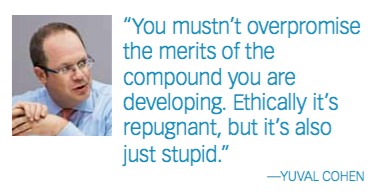
everyone, including the patient, because it often leads to disqualification of the trial itself.
Giovinazzo: The most critical element in working with patient communities is to listen. Failure to do so will create all sorts of problems that can diminish the value proposition around your brand.
PE: How does the financing picture look like today for your development programs? Is it getting harder to raise money from investors now that the capital markets in life sciences are showing signs of fatigue?
Funtleyder: We are seeing more convergence in the financing market. Public investors are moving downstream to the private arena, while many private venture funds are moving upstream and taking stakes in public companies. It’s a very fluid situation. Google has its own venture capital business for the life sciences, Verily. PayPal is building a fertility app for women. Uber is adding a new service specifically targeted at healthcare, for patients with special health needs. And UPS, Fed Ex, and Lonza are launching new business units on medicines logistics. Healthcare is a $3 trillion industry-everyone wants in. This makes for some interesting bedfellows. Ultimately, however, I think this expanded field of players is a positive trend. It keeps the healthcare market competitive when you have different perspectives vying for consumer endorsement.
One drag on the market potential of healthcare is the asymmetry of information. Progress depends on the ability to apply information-big data-to bridge the many functional silos that perpetuate inefficiencies in access and delivery of care to patients. What’s disappointing is that the technology exists to fix this, allowing more people to access not just raw data but the informed analytics that deliver evidence without bias to guide the choices of everyone, from large insurers and payers to the individual patient.
Cohen: Corbus did not pursue the traditional IPO route. We first financed the company privately, then listed it on a public exchange and subsequently became a Nasdaq listed company. We did all this in less than 12 months, which is unusually fast. Our backers were not VC funds but a mix of institutional investors and private individuals, who could decide quickly. We did the right thing, as there are advantages in being a public company, especially in accessing funds. The pool of potential investors from non-traditional sources is growing, including constituencies from the CFF to the National Institutes of Health.
PE: How do external partnerships figure in your development and market growth plans?
Wright: Our venture with Proteus has been funded entirely from internal sources. While Otsuka is a 95-year-old pharmaceutical company, we operate much more like a start-up enterprise. We have our own rally points and stage gates and a unique culture that many describe as “big venture.” The two companies operate well together because there is a joint commitment to the technology and the potential it has for patients. It’s an inquisitive culture that encourages exploration of business opportunities not traditionally within pharma’s turf.
Cohen: We don’t have any partners at the moment. Partnering is not a major component of our business plan. Corbus focuses on rare diseases that do not require large investments in a sales force or other drivers of overhead. In CF, for example, there are only about 100 physicians in the US that treat our prospective pool of patients. We can address their needs with a small, specialized sales team. Another disincentive for us is the impact of all the M&A activity, especially in big Pharma. It has a destabilizing impact on trust. If we go to a big company for a pitch, only to return home to read about fresh rumors of a buyout, my first thought would be how relevant was my meeting today? Will my potential liaison partner still have a job a year from now?
PE: What’s the one message you want to put forward to your principal stakeholders? Is there an unresolved priority issue that, if addressed, will contribute most to the growth and P&L prospects of your company in the next few years?
Clarke: Smaller public companies like mine require stability in the public markets to allow for a fair representation of the value of our technology. It is anathema to sustainable long-term growth that low volume trades on a low float stock can negatively alter a company’s market value. It adversely impacts future fundraising required to

support the commercialization of desperately needed new therapies. Of course, strong data is a catalyst that can alleviate these concerns.
Cohen: The process of developing a new drug, beginning at the clinical stage, remains remarkably inefficient. It is too long and cumbersome. Consider all the different constituencies a developer must deal with, from academia, where we must negotiate clinical trial sites; to the FDA, with its numerous review panels; to the payers, with their conflicting standards about value and cost effectiveness. There is also the complexity and duplication when addressing regulatory standards on a cross-border basis. Just importing a drug into Europe for use in a local clinical trial is a full-time venture in and of itself. We’d like to see more allowance for private sector initiative as a way to balance government controls and regulation.
Wright: Our concern is the pace of overall technology improvements compared to improvements in new drugs and medical devices. Unfortunately, while you have a fairly definitive standard for reimbursement in place for drugs and devices, technology improvements that focus on keeping people well are ignored. Incentives that reward this outcome are not recognized in the reimbursement system, to the extent they should be. Despite their potential for significant cost savings, payment and reimbursement rules have yet to even touch those technologies that stimulate positive behavioral changes in health. Auto insurance companies give discounts to customers who have a safe driving record. Why can’t we extend that thinking to healthcare? Where is the incentive to stay well?
Giovinazzo: Regulatory approval and reimbursement should be better coordinated in advance rather than separated into silos, as is the case today. Alignment between the two is more likely to ensure that all patients who qualify in terms of need obtain access to these new therapies, on a timely basis.
Funtleyder: A lot of change is going to be induced by the next generation, which is better positioned to use the new technology rather than being intimidated by it. The demand for more personalized care will likely force you in business to adjust your operating model: there will be much more consumer “pull” on the system, rather than the “push” from suppliers we experience today. Reimbursement rules will certainly be influenced by this change, with greater spread in how we pay for services among government, insurers, providers and patients. We will likely need a philosopher king to sort it all out. I certainly don’t see any of our current politicians resolving the question.
William Looney is Pharm Exec’s Editor-in-Chief. He can be reached at wlooney@advanstar.com
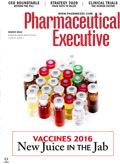
Addressing Disparities in Psoriasis Trials: Takeda's Strategies for Inclusivity in Clinical Research
April 14th 2025LaShell Robinson, Head of Global Feasibility and Trial Equity at Takeda, speaks about the company's strategies to engage patients in underrepresented populations in its phase III psoriasis trials.
Bristol Myers Squibb’s Cobenfy Falls Short in Phase III Trial as Add On Therapy for Schizophrenia
April 23rd 2025In the Phase III ARISE trial, Cobenfy administered as an adjunctive treatment to atypical antipsychotics for patients with inadequately controlled schizophrenia did not achieve statistically significant improvements.
Expanding Immune Response Testing to Support Vaccine Development
April 22nd 2025Nigel McCracken, chief operating officer, Virax Biolabs, discusses the expansion of its ViraxImmune platform into areas such as transplant monitoring, vaccine efficacy, latent virus reactivation, and CAR T cell therapy.